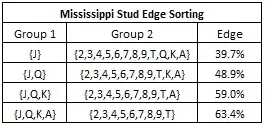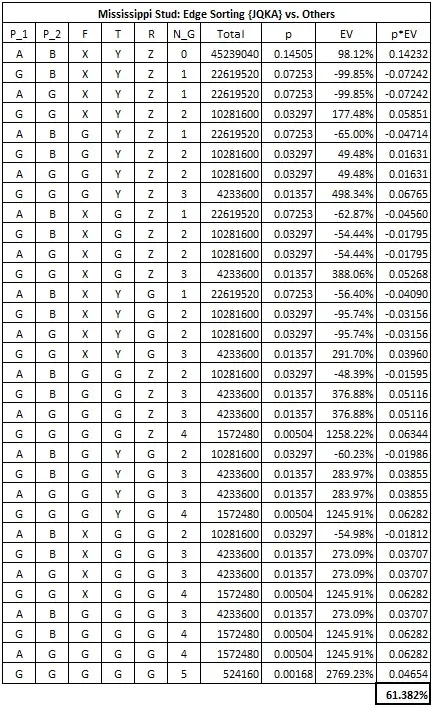In this post, I gave details about edge sorting Mississippi Stud (MS) by considering the sort where Jacks are oriented in one direction, while non-Jacks are oriented in the opposite direction. The question arises if there is an improvement over the Jack/non-Jack sort? Can the AP do better than 39.489%? This question was recently answered by Stephen How in this post he made on his blog.
The most common pay table for MS is as follows:
- Royal Flush pays 500-to-1.
- Straight Flush pays 100-to-1.
- Four of a Kind pays 40-to-1.
- Full House pays 10-to-1.
- Flush pays 6-to-1.
- Straight pays 4-to-1.
- Three of a Kind pays 3-to-1.
- Two Pairs pays 2-to-1.
- Pair of Jacks through Aces pays 1-to-1.
- Pair of Sixes through Tens is a push.
- All other hands lose.
The house advantage for this pay table is 4.9149%. Stephen’s work used this same pay table, with the exception that a Straight pays 5-to-1. In this case, the house edge is reduced to 3.7591%, making advantage play slightly more lucrative.
Stephen considered edge sorting with various groups of cards. Along with double checking my Jack/non-Jack result, he also considered the groups {J,Q}, {J,Q,K} and {J,Q,K,A}. Stephen took a shortcut — he obtained his results by simulation and didn’t quantify the strategy. As long as he is not attempting to precisely quantify basic strategy or get an exact house edge, there is no harm is just running a bunch of hands at random. If his goal was to approximate the potential edge for various sort groups, he has more than succeeded.
The following table summarizes Stephen’s results:

Note that the Jack/non-Jack result is improved from 38.489% to 39.7% because of the improvement in payout for the straight.
Because of the extraordinary result Stephen obtained for the {J,Q,K,A} sort, I decided to analyze that sort in detail. My analysis uses the same methodology as the Jack/non-Jack sort. In what follows, let
- Group 1 = {J,Q,K,A}
- Group 2 = {2,3,4,5,6,7,8,9,T}
I will use the letter “G” generically for any card in Group 1. That is,
G = {Jack, Queen, King, Ace}.
A review of the way MS proceeds is important to a complete understanding of the way edge sorting works for the game. First, the player is dealt 2 cards, denoted P_1 and P_2. Then three cards are placed face down in front of him. These three cards will be exposed in order as the Flop (F), Turn (T) and River (R) cards.
For the player’s first card, I will use the letter “A” when it is not in G. The player’s second card will be referred to by the letter “B” when it is not in G. Then there are four possible player starting hands:
AB, GB, AG, GG.
Next, consider the three edge-sorted dealer cards, Flop, Turn, River, that are face-down in front of the AP. I will use the letter “X” for a card that is not in G on the Flop, “Y” for a card that is not in G on the Turn, and “Z” for a card that is not in G on the River. There are then eight different edge-sorted groups of cards the AP can distinguish:
XYZ, GYZ, XGZ, XYG, GGZ, GYG, XGG, GGG.
There are then 4×8 = 32 possible combinations for the distribution of Group 1 cards between the player’s hand and the three face-down cards. The following table gives the combinatorial analysis for edge sorting MS with the {J,Q,K,A} sort. This computation shows a player edge of 61.382% for the AP.

Note that the edge of 61.382% is slightly lower than the simulated result obtained by Stephen How of 63.4%. Again, this is because Stephen did his analysis with a straight paying 5-to-1, whereas my analysis assumes a payout of 4-to-1 for a straight.
The following eight Excel files give perfect edge-sort strategy on the Flop wager, after the AP views his two cards and the edge sorts of the three hidden cards. The first two columns give the AP’s cards. The third column gives the EV of folding on the Flop. The fourth column gives the EV of raising 1 unit on the Flop. The fifth column gives the EV of raising 3 units on the Flop. The final column gives the basic strategy decision.
In my post on the Jack/non-Jack strategy, I condensed these eight files into a summary strategy file. I am going to forgo this exercise here.
MS continues to amaze. No game comes close to this one in terms of the magnitude of vulnerabilities. If you’ve got MS, watch it closely! Even a $25 player can devastate the game.


